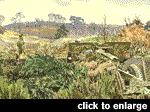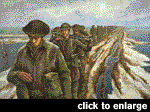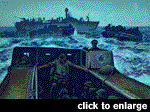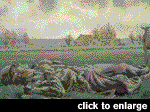





Alex Colville's War Drawings |


|
Genesis of a Painting: Alex Colville's War Drawings
by Laura BrandonCanadian Military History Vol. 4, No. 1 (Spring 1995), 100-104.In the past few years a number of publications have appeared which examine Alex Colville's drawings.* They reveal that Colville's graphic work almost invariably forms the preliminary step to a composition in another medium. At times many years pass between these stages. Sometimes the finished painting is extremely close to the original drawing. Other sketches form the basis for only a small detail in a picture. More recent drawings involve complex calculations designed to correctly transpose a three-dimensional scene onto a two-dimensional surface. None of the publications, however, look at Colville's early drawings as represented in the art collection of the Canadian War Museum. Nor do they make more than a cursory link between Colville's official war paintings, whose genesis lies in field sketches, and his current output. |

|
In 1982, Alex Colville donated his remaining wartime drawings and sketches to the Canadian War Museum to join those that had already become part of the War Art Collection. These were works that he had not been required to hand over to Canadian War Records officials. The Museum now holds 371 works on paper by this artist. Many had been published earlier in a book, Colville: Diary of a War Artist,*2 and a subsequent exhibit organized by the Museum in 1987 consisted of a significant number of works on paper from both collections. As a consequence of this activity, the connection of many drawings to the paintings he completed as an official War Artist during the Second World War was made later. With others, however, a connection was not made or was not immediately obvious. This article traces the linkage of the drawings to six major oil paintings and two important watercolours completed during the last six months of the war.In some cases a previously unidentified sketch is linked to a painting for the first time in an initial attempt to more concisely document Colville's graphic war art. As well, a brief analysis will be made of the relationship of Colville's war sketches to finished paintings in order to cast light on the artist's creative processes during his war years. |

| Infantry, near Nijmegen (Canadian War Museum No. 12172), a 40" x 48" canvas depicting soldiers of the 3rd Canadian Infantry Division trudging along a Dutch polder, is a well-known image which hangs in the museum. Fifteen separate sketches can be associated with this work.*3 One, for example, is of the leading figure minus his head and left hand (CWM 12145). The hand appears in a separate study (CWM 82370). The preliminary drawings also show us that Colville worked with two concepts of the finished work. One features the figures moving towards the viewer, and the other, away. The only completed watercolour painting is of the latter (CWM 12170) and suggests that the final familiar composition was not the one the artist initially chose to develop. |

|
Six works on paper in the Museum's collection can be associated with Bodies in a Grave (CWM 12122), a 30" x 40" canvas currently on loan to the National Gallery of Canada. Four drawings directly relate to this painting and two progressed no further.*4 One pencil sketch (CWM 12123) shows the complete composition while another (CWM 82323) is similar but squared not transfer. A far rougher sketch (CWM 82324) is difficult to place chronologically. Its concentration on certain key figural elements in the composition suggests that it followed 12123 but preceded 82323, in that additional lightly drawn figures present in 12123 cannot be seen in either this sketch or the squared 82323. The watercolour study (CWM 82408), currently on view in the Museum, features the yellow background which appears in the final painting. The presence of two left arms for the upper figure in this work shows that Colville had not resolved the hand position. Indeed, in the final painting this detail finds resolution not present in any of the sketches. |

| Tragic Landscape (CWM 12219), also on loan to the National Gallery of Canada, is another large oil painting. Its genesis lies in a number of sketches, studies and watercolours, different parts of which were gathered together in the final picture. The dead paratrooper has as its source a watercolour study (CWM 12142). The houses in the background in the painting are the subject of a watercolour, Platoon Position in an Orchard (CWM 12196). The complete composition exists squared for transfer in a wash drawing (CWM 82411). The two cows to the left and centre background of this study were ultimately taken out and replaced by a road sign. One that appears in a watercolour, Standard Oil Gas Station (CWM 12210), is similar but not the definitive source. A series of three works on paper for The Nijmegen Bridge (CWM 12187), which will be on view in the Museum in the 1995-6 exhibition, Victory, shows a continuous development from the initial sketch to the finished work.*5 The major changes in composition deal with the size, type and placement of vehicles. If anything, this only serves to remind us that the final composition is an imaginative rearrangement and not a literal rendering of things observed. |

|
Exhausted Prisoners (CWM 12152), a 30" x 40" oil painting confirms the important role of the creative process in the genesis of war art. There are nine drawings associated with this composition *6. Six relate to the figures of the prisoners, either singly or as a group; two find their subject in the artillery piece in the background; and one, entitled Armed Cars in Nijmegen (CWM 12114), provides the background ruins and, interestingly, the vehicle which appears in the right foreground of The Nijmegen Bridge. A complete contrast to the development of these major oil paintings is found in the watercolour painting London Bridge (CWM 12177). This work stands alone as a composition in its own right and was never developed into an oil painting. The few sparse lines of the preliminary drawing (CWM 82237) show that Colville could identify and capture the complete content of a final composition in minutes. In the watercolour Cutting Firewood near Nijmegen (CWM 82457), it is clear from the studies that questions of compositional balance preoccupied the artist. The figurative group to the left, the vehicle to the right and the basic landscape elements are rearranged three times in some swiftly drawn sketches in the Museum's collection. (CWM 82203, 82202) The lack of any oil paintings associated with these two works suggests that the artist could find no more to say about those subjects and chose not to develop them further. Not every drawing from the war years provided him with the inspiration necessary to move into oil. And it was with the oil paintings that Colville demonstrably moved from being an artist who recorded what he saw (as in London Bridge) to one who grasped the significance of what he saw, and was able to muster his artistic and imaginative resources to capture it on canvas (as in Infantry, near Nijmegen). This is not to say that London Bridge or Cutting Firewood near Nijmegen are not good paintings but rather to suggest that they have, as subjects, not been transformed by the artist's moment of vision. Colville recognizes that not all subjects can become great paintings. Sometimes the subject itself is limiting and at others the artist himself feels he cannot do it justice. In a recent CBC interview Colville admitted that he had been overwhelmed by what he saw at Belsen and had not felt able to deal with the enormity of what he saw adequately in paint. *7 Current writing on Colville's art attributes his bleak existentialist view of the world as viewed in his recent and not-so-recent art as harkening back to his war years. *8 There is no doubt that many of his post-war compositions find a direct echo in his war paintings. Traveller of 1992 *9 is compositionally related to The Nijmegen Bridge and shares the road and bridge motif. The hanging arm of the woman in Woman on Diving Board of 1993 *10 makes a direct reference to the dead arm of the upper figure in Bodies in a Grave. Finally, the supine figure on a bench in Köln Express looks back to the dead paratrooper in Tragic Landscape and the central prisoner in Exhausted Prisoners. Such echoes and re-echoes demonstrate that Colville is still absorbed in certain subjects from his war years, subjects which drove and still drive his creative imagination, and which had their genesis in the war drawings he made in the fields and cities of war-torn Europe.
Notes* These include Gemey Kelly, Alex Colville: Selected Drawings. New Brunswick: Anchorage Press, 1993 (Exhibition Catalogue), Philip Fry, Alex Colville: Paintings, Prints and Processes, 1983-1994. Montreal: Museum of Fine Arts. 1994 (Exhibition Catalogue). *2 Graham Metson and Cheryl Lean, Alex Colville: Diary of a War Artist, Halifax, Nova Scotia: Nimbus Publishing,1981. *3 Catalogue numbers 12145, 12170, 82204, 82205, 82206, 82218, 82219, 82220, 82370, 82373. *4 These two are catalogue numbers 12121 and 12143. *5 Catalogue numbers 82404, 82403, 13134. *6 Catalogue numbers 82326, 82254, 82255, 82256, 82410, 12114, 82327, 121205. *7 "Canada at Large," CBC Prime Time News. February 7,1995. *8 For example see Gillian MacKay in "6 Paintings by Alex Colville: a Symposium," Canadian Art, Vol. 11, No.4,Winter/December 1994, p.24. *9 Traveller, 1992, Redpath Gallery, Vancouver. *10 Woman on Diving Board, 1989,Private Collection. Köln Express. 1986, Mrs. P. Marko Collection. Laura Brandon is the Curator of War Art at the Canadian War Museum, Ottawa, Ontario. |

    
|


